How Kenya is controlling locust plagues
One year after millions of the voracious insects invaded the country, specialist hunters have developed a system to defeat them. The UN Food and Agriculture Organization has declared the operation a near-total success. EL PAÍS boards a control and fumigation plane to see the mission in action
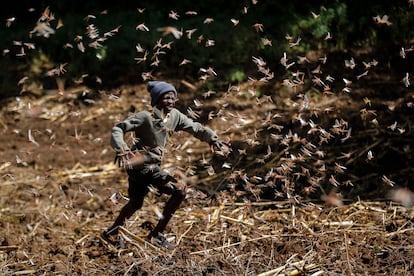
At the beginning of 2020, a plague on a scale that had not been witnessed in decades descended on the Horn of Africa: billions of desert locusts crossed the borders from the Arabian Peninsula, ravaging farmland and fields of crops and placing the food security of 32 million people in danger, according to the initial warnings of the Food and Agriculture Organization of the United Nations (FAO). After a series of droughts and seasonal floods, the climatic extremes that the region witnessed over the course of last year created the perfect conditions for these insects to reproduce in Biblical proportions.
Six months after the first wave arrived, by August 2020, 650,000 hectares had been fumigated with biopesticides, eradicating 440 million locusts. The plague was being beaten back but it was still too early to declare complete victory. Today, the battle is still being waged. One of the most active fronts is located in the north of Kenya. There, the FAO joined forces with the private sector, tribal leaders and the Kenyan government to combat the swarms. In densely populated areas, efforts to control the infestation have to be carried out on the ground, with trackers who spray insecticide from specially modified backpacks or from machines mounted on the backs of trucks.
However, this method is unworkable in the vast plains and extensive forest land in the north of the country. As such, the authorities have opted for a system whereby helicopters are sent from local aerodromes to scout the area on surveillance missions and record information on the location and dimension of individual swarms. This data is then relayed to the joint operations control center, where a team of experts in various fields decides where to deploy the so-called “locust air force,” airplanes equipped with delivery systems capable of dropping insecticide in huge amounts on specific targets.
“Last year we didn’t have any data,” says Casper Sitemba of the FAO. “When we started, people would phone in to report sightings of locusts but we have now deployed various technical means to cover the data gap. We have created several applications and with their help we have been able to collate enormous quantities of data. Right now, the success rate of our control operations is almost 86%. Now we are able to see the results. Last year we didn’t even know how many swarms there were, or where they were when the plague first arrived.”
According to the FAO, the operation in the north of Kenya has been a “great success.” Sitemba calculates that as things stand there are only a few swarms remaining and these are not that considerable. “They are what we call mini-swarms: groups of locusts that have split off from other larger swarms. These can cover an area of between 20 to 30 hectares, whereas last year some were extended over an area of 3,000 hectares. We are scaling back the size of the operation now that the situation has greatly improved, but we are remaining on alert given the rainy season is around the corner,” Sitemba explains.
To get an idea of how a plague of locusts is tackled from the air, we rode along on a surveillance flight in one of the data-gathering helicopters to see how the fight to save Kenya’s agricultural lands is being taken to the invaders.
1. Taking to the air!

Helicopters and airplanes used by the FAO at the Nanyuki aerodrome. The airplanes are fitted with fumigation-delivery mechanisms to spray insecticide over large locust swarms.
2. The locust hunter

Before the Covid-19 pandemic and the arrival of the locusts, Kenyan pilot Chris Stewart used to ferry celebrities, royalty and other people to luxury hotels in exclusive conservation areas. Now he hunts locusts. “It’s easy to confuse smoke or dust clouds with a swarm, and if the insects are resting in trees they look like acacia flowers,” he says.
3. In Samburu and Isiolo
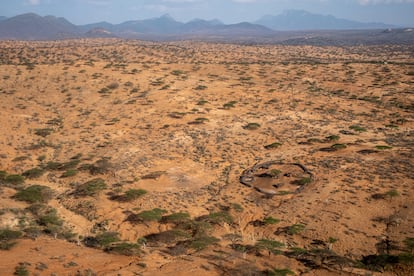
In areas of northern Kenya like the counties of Samburu and Isiolo, semi-nomadic shepherds live with their flocks. From the air it is easy to distinguish their homes, inside compounds known as bomas, which are made from acacia roots to prevent predators from attacking the livestock at night. As the area is not very heavily populated, it is possible to use aircraft to spray locust swarms with pesticides.
4. A possible sighting?
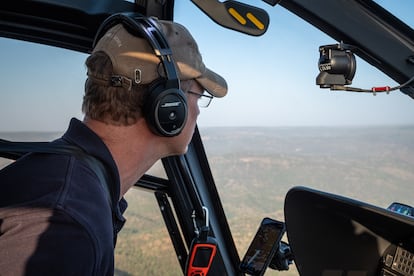
“I think I see something,” says Stewart as he swings the helicopter around on a sharp turn to check out a possible swarm. On his iPhone he receives information from the operations center in Lewa, where a team of experts compiles data about sightings and possible locations.
5. Data dive

Stewart was spot on: at the top of a mountain in Isiolo a swarm of locusts is resting on the ground. The pilot swoops over the area and punches GPS coordinates into his phone to measure the size of the swarm in hectares. He also takes note of wind direction, in case the swarm takes to the skies again. With this information in hand, the analysts can predict which way the insects may head next.
6. Cold-blooded creatures

After daybreak, desert locusts tend to remain in the same place they settled for the previous night. They are cold-blooded nomads who rarely spend two nights in the same spot. When morning comes, they wait for the ground to warm up and the air to heat their bodies before setting off in search of more greenery to devour.
7. The operations room

Yussuf Kurtuma, Christine Kebaba – both employees of tech company 51 Degrees, which helps track the locusts – and Casper Sitemba are looking at a data-filled screen. In the operations room information from Somalia, Ethiopia and Kenya is compiled and analyzed. “We gather together all the information people in the villages give us,” says Kurtuma. “The elders and the trackers employed by various different companies collect it. We compile all of this information in one platform and then we share it with all of the people working on the ground to stop the desert locusts.”
8. Final goal: to prevent hunger
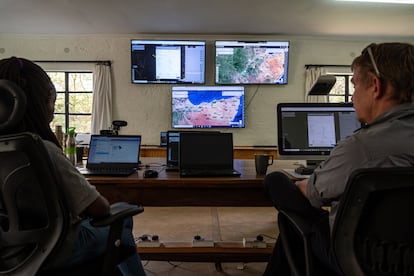
The data collected by the helicopter crews is sent to the joint operations control center at Lewa, where 51 Degrees employee Christine Kebaba helps to monitor the movement of the swarms. “It’s exciting knowing that I’m working to help guarantee food security in the Horn of Africa by exterminating desert locusts,” she says. “If we weren’t on top of the situation a lot of people would go hungry because food would be scarce; the locusts would have eaten it.”
9. A coordinated effort
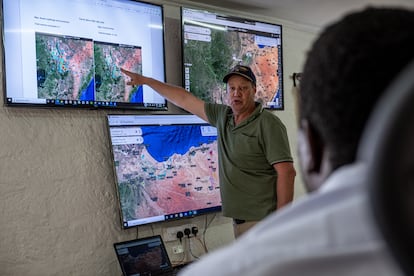
Technical analyst Heath McRae presents data about the desert locusts to Martin Gichuru, who works for a British government consultancy. In the control center, private sector employees work together with government officials and experts as well as the Kenyan Army. The FAO campaign is funded by various institutions, among them the UK Foreign and Commonwealth Office.
10. Memories of a Samburu elder
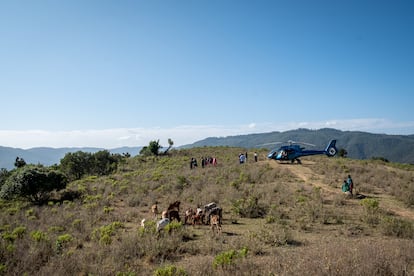
Once the coordinates have been sent to the control center in Lewa, a fumigation aircraft is dispatched. Meanwhile, the surveillance chopper awaits its arrival on a mountainside nearby. Its presence draws the attention of some Samburu tribesmen. An elder, or mzee, recounts his memories of a plague of locusts that descended in the area in 1950.
11. A photo op
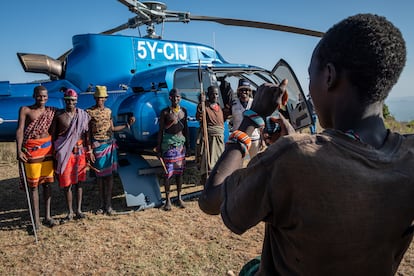
Several Samburu Warriors and elders gather around the helicopter to see what’s happening. While the crew waits for the arrival of the aircraft, the Samburu men take the opportunity to snap a few photos.
12. The fumigation aircraft arrives
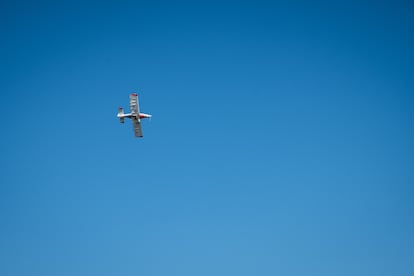
The aircraft is spotted in the air. Although it has the FAO’s blue logo on its wings, these aircraft are owned by a private company. Some of the airplanes equipped for the distribution of pesticides arrive in Africa from as far away as Canada.
13. A dangerous operation
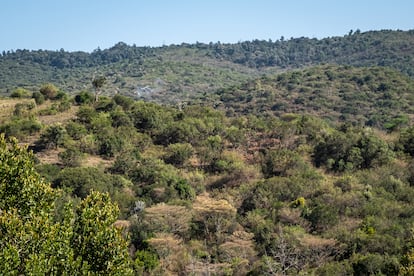
While the aircraft sprays the locust-infested brushland with pesticides, the helicopter crew keep a safe distance before examining the area. Fumigation is a dangerous operation: a few weeks ago, an aircraft went down in Ethiopia, killing its pilot.
14. The damage the locusts cause

“A little over a year ago, billions of locusts blanketed the area,” says Sitemba of the FAO, holding a locust knocked unconscious by the fumigation. “This has been one of the worst plagues in over 70 years. It has put the food security and subsistence of some of the most vulnerable people in northern Kenya at risk.”
15. Insatiable
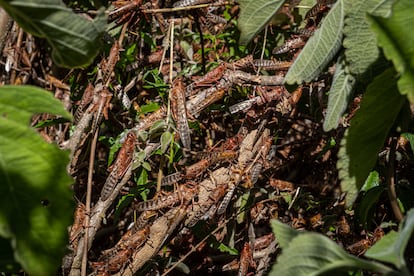
A male locust can reach up to six centimeters in length and a female, nine centimeters. They are always hungry and can consume the equivalent of their own body weight in a single day. They feed on rice, millet, corn and sugar cane and devour practically every part of the plant.
16. From swarms to mini-swarms

Although the fumigation aircraft has covered most of the locust swarm, it is practically impossible to get every single one of the insects. There are always smaller groups that manage to split away from the main swarm. When this happens, the mini-swarms that emerge can cover areas of between 20 and 30 hectares.
17. Working alongside animals
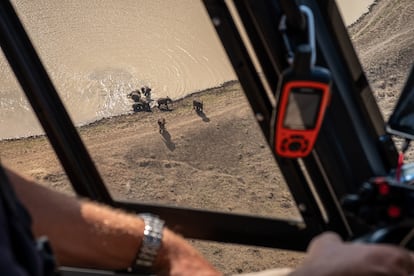
The operations center in Lewa is located in a national park in the north of Kenya. The airplanes land and take off from a narrow runway surrounded by wildlife including giraffes, elephants and rhinos.
18. Checking the impact
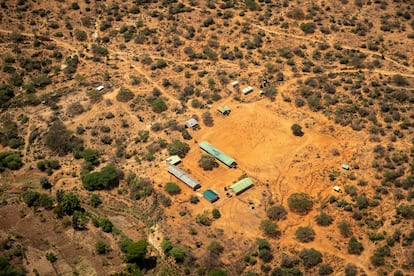
The fumigation aircraft can only operate in zones where there are no nearby water sources, livestock or villages. The insecticide used has been certified safe by the United Nations, but to make sure the areas sprayed are periodically checked.
19. Swarms of up to 80 million insects

On the return trip to Lewa, a cloud of locusts appears on the horizon. A swarm can contain millions of hungry insects, with between 40 and 80 million locusts on average. Although desert locusts are happy to live individually, when they find themselves in large groups they become sociable. “A year ago, we didn’t have the systems or the capacity for managing data to take on a plague,” says Sitemba. “But little by little we have developed them and, if an invasion comes, we will be ready for it.”
English version by Rob Train.
Tu suscripción se está usando en otro dispositivo
¿Quieres añadir otro usuario a tu suscripción?
Si continúas leyendo en este dispositivo, no se podrá leer en el otro.
FlechaTu suscripción se está usando en otro dispositivo y solo puedes acceder a EL PAÍS desde un dispositivo a la vez.
Si quieres compartir tu cuenta, cambia tu suscripción a la modalidad Premium, así podrás añadir otro usuario. Cada uno accederá con su propia cuenta de email, lo que os permitirá personalizar vuestra experiencia en EL PAÍS.
¿Tienes una suscripción de empresa? Accede aquí para contratar más cuentas.
En el caso de no saber quién está usando tu cuenta, te recomendamos cambiar tu contraseña aquí.
Si decides continuar compartiendo tu cuenta, este mensaje se mostrará en tu dispositivo y en el de la otra persona que está usando tu cuenta de forma indefinida, afectando a tu experiencia de lectura. Puedes consultar aquí los términos y condiciones de la suscripción digital.
More information

The lure of forbidden meat
Archived In
Últimas noticias
Most viewed
- Charles Dubouloz, mountaineering star, retires at 36 with a farewell tour inspired by Walter Bonatti
- The Florida Keys tourist paradise is besieged by immigration agents: ‘We’ve never seen anything like this’
- CBS in crisis after pulling a report on Trump’s deportations to El Salvador (which later leaked online)
- Chevy Chase, the beloved comedian who was a monster off camera: ‘Not everyone hated him, just the people who’ve worked with him’
- From Gwen Stefani to Katy Perry: The MAGA drift of celebrity Democrats









































